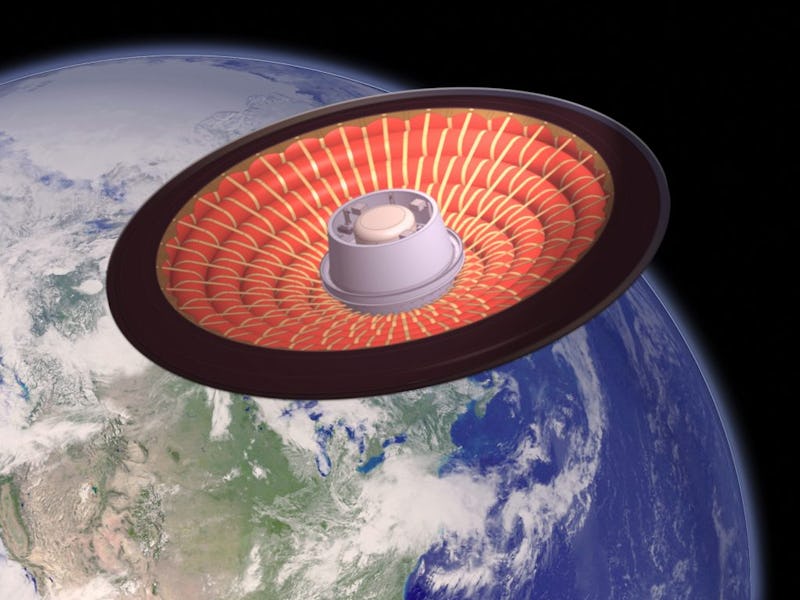This giant inflatable heat shield could be our best shot for future Mars settlements
It’s (literally) expanding our space travel possibilities.

A new type of heat shield was successfully tested last week, with the hopes this type of inflatable decelerator could be used in the future to land humans and large payloads on Mars, or for atmospheric entry on other planets on moons. Decelerators are used to slow down space vehicles as they land.
The Low-Earth Orbit Flight Test of an Inflatable Decelerator (LOFTID) was launched aboard a United Launch Alliance (ULA) Atlas V rocket on November 10 from the Vandenberg Space Force Base in California. LOFTID was a secondary payload on the launch of the Joint Polar Joint Polar Satellite System-2 (JPSS-2) weather satellite.
The ablative heat shields that have been used previously have a limit on how big of a payload they can safely deliver to planets and moons with atmospheres. Inflatable decelerators have been considered the best hope on the horizon for making human enterprise on Mars possible.
The cone-shaped LOFTID is 6 meters (19.7 ft) in diameter, making it the largest blunt body aeroshell to ever reenter space.
“Currently, using rigid technologies, we’re limiting the size of the aeroshell itself to fit within the fairing of a launch vehicle, or no more than about five meters across,” said Joe Del Corso, LOFTID project manager, speaking at a pre-launch briefing in October. “That limits the size of payloads delivered to the surface of Mars to about 1.5 metric tons.”
LOFTID pack and deployment testing started with a load test to verify that the heat shield will perform as expected in flight under real-life conditions
However, a larger aeroshell that uses inflatable technology could enable much heavier payloads, up to the range of 20 to 40 metric tons, Del Corso said. “It’s what you need to put humans on Mars,” he said, adding that larger aeroshells would also enable access to higher terrains on Mars where the atmosphere is not dense enough to slow down vehicles with existing systems.
The LOFTID was inflated before separating from the Atlas V’s Centaur upper stage and then reentered the atmosphere over the Pacific Ocean. NASA said the aeroshell and a data recorder were recovered so that engineers can review the data on how well it worked. A backup data recorder module was also ejected before it splashed down under a parachute, in case LOFTID and the primary data recorder were lost at sea.
(Literally) expanding capabilities
Back in 2012, a prototype for a large inflatable heat shield called an Inflatable Reentry Vehicle Experiment (IRVE-3) was tested successfully, after launching on a sounding rocket and surviving at hypersonic speeds through Earth’s atmosphere. Since then, more work on the development of Hypersonic Inflatable Aerodynamic Decelerator (HIAD) technology allowed this current test to be conducted. The data from this test will inform future configurations and tests.
LOFTID is made of a stack of pressurized concentric rings known as tori composed of braided synthetic fibers that are 10 times stronger than steel by weight. The reentry system is equipped with a flexible thermal protection system that insulates the rings from heat in excess of 1,600 degrees Celsius (2,900 Fahrenheit). The foldable, scalable heat shield takes up less room in a launch vehicle.
NASA said the LOFTID technology creates more drag than traditional heat shields and starts to decelerate in the upper levels of the atmosphere.
“Proving new technologies through flight tests is one of the main ways we expand capabilities for future missions,” said Jim Reuter, associate administrator for NASA’s Space Technology Mission Directorate. “We were pleased to work with our ULA, NASA science, and NOAA colleagues to perform this technology demonstration in conjunction with JPSS-2’s launch.”
This article was originally published on Universe Today by NANCY ATKINSON. Read the original article here.
This article was originally published on